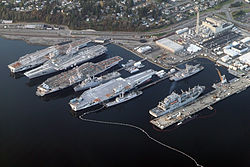Naval Base Kitsap
This article needs additional citations for verification. (February 2019) |
| Kitsap | |
|---|---|
| Near Bremerton, Washington in the United States | |
 An aerial view of Puget Sound Naval Shipyard & Intermediate Maintenance Facility at Naval Base Kitsap during 2012 | |
 | |
| Coordinates | 47°43′14″N 122°42′47″W / 47.72056°N 122.71306°W |
| Type | Naval base |
| Area | 12,000 acres (4,900 ha) |
| Site information | |
| Owner | Department of Defense |
| Operator | US Navy |
| Controlled by | Navy Region Northwest |
| Condition | Operational |
| Website | Official website |
| Site history | |
| Built | 1942 (as Naval Submarine Base Bangor) and 1946 (as Naval Station Bremerton) |
| In use | 2004 (as merged base) |
| Garrison information | |
| Current commander | Captain John Hale |
Naval Base Kitsap is a
It also provides service, programs, and facilities for their hosted combat commands, tenant activities, ships' crews, and civilian employees. It is the largest naval organization in Navy Region Northwest, and composed of installations at Bremerton, Bangor, Indian Island, Manchester, and Keyport, Washington. It received the 2005 and 2017 Commander in Chief's Award for Installation Excellence - the Best Base in the U.S. Navy.[2]
History
Bangor
Serving the
Bremerton
This installation is home to the
Naval Base Kitsap is also home to Naval Hospital Bremerton.
Protest
In November 2009, five protesters, including 82-year-old priest
Environment
In 2010, after purchasing the base's first hybrid bus on April 29, 2010, Naval Base Kitsap purchased two additional hybrid buses, with five others to be delivered by the end of July. The diesel-electric vehicles are the Navy's first hybrids and were funded through the
In March 2020, private water wells of homes surrounding Bangor have been found to be contaminated with
Units, warships and submarines
(as of February, 2023) [7]
- Commander, Carrier Strike Group Three
Bangor
|
Bremerton
|
See also
References
- ^ a b "Kitsap Navy base is getting a new boss". The Seattle Times. January 11, 2011. Retrieved January 12, 2011.
- ^ "Naval Base Kitsap - About > Mission". Retrieved June 10, 2009.
- ^ "Disarm Now Trident Plowshares Action". nuclearabolitionist.blogspot.com. November 2, 2009.
- ^ "William Jerome Bichsel, inmate # 86275-020". Federal Bureau of Prisons, U.S. Dep't of Justice.
search for "86275-020"
- ^ Waller, Darrell (July 1, 2010). "Navy Buys First "Green" Buses for Naval Base Kitsap". US Navy. Retrieved January 12, 2011.
- ^ Farley, Josh (March 10, 2020). "Well near Bangor found to have potentially dangerous levels of contamination". Kitsap Sun. Retrieved December 10, 2021.
- ^ "Naval Vessel Register". Naval Vessel Register. Retrieved February 27, 2023.
- ^ SSN21
- ^ SSN721
- ^ SSN722
- ^ SSN751
External links
- NB Official website
- globalsecurity.org: Bangor
- globalsecurity.org: Bremerton
- Post-Vietnam: Non-Violence at Bangor, a multimedia history of protests at the Bangor Military Base from the Pacific Northwest Antiwar and Radical History Project.
- Defense Commissary Agency



